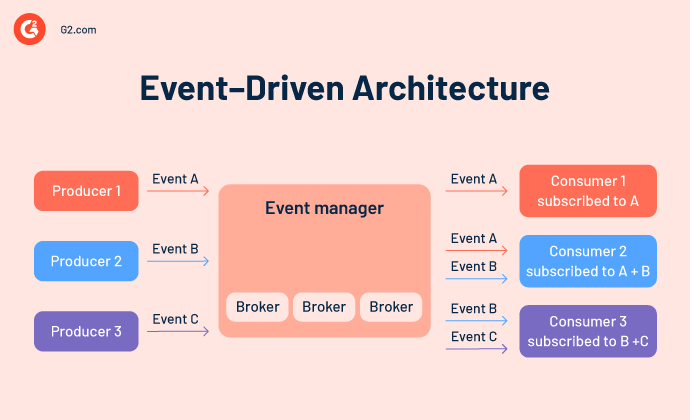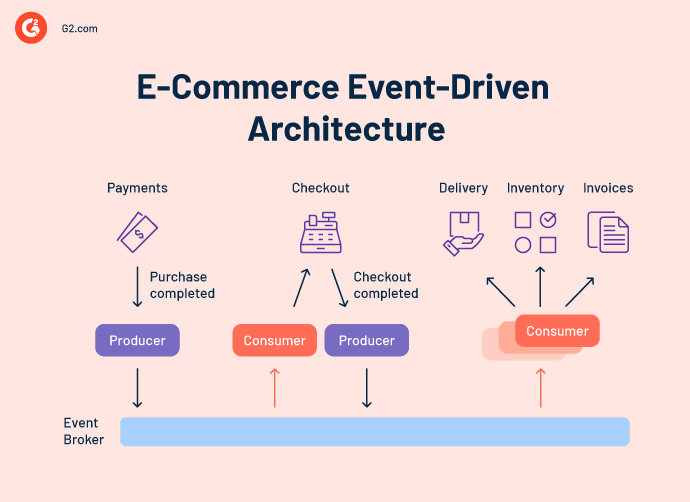Enterprises rely on various technologies and tools to operate their business effectively.
Still, these can quickly become outdated, leading to performance degradation, increased cost and risk exposure, and security threats. It’s not hard to see how old-fashioned, monolithic architectures often bottleneck your business's modernization.
One way to improve the agility and scalability of your IT infrastructure is to employ an event-driven architecture. In an event-driven architecture, systems are built around events, which are messages that indicate something has happened. This makes it possible to build systems that react quickly to changes in their environment, making them more agile and adaptable.
Most event-driven systems use message queue software to communicate between disparate systems and enable real-time communication on a single layer.
What is event-driven architecture?
An event-driven architecture (EDA) is a software design pattern where events trigger actions and enable communication between decoupled components. This approach enhances system responsiveness, scalability, and speed, ensuring faster adaptation to business changes and machine failures.
The event-driven architecture process pattern replaces the conventional "request/response" design in which services had to wait for a response before proceeding to the next activity. It also offers real-time data insights into user behavior, business processes, and operations.
Events govern the flow of event-driven architecture, which is meant to react to events or perform operations in response to an event.
What does it mean to be event-driven?
Events are instances of actions. They occur when anything happens within or outside of your business. These activities can include a consumer purchase, a warehouse inventory update, an attempted data breach, or a change in status for an application.
Since many events are time-sensitive or mission-critical to business operations, companies want to design their infrastructures around collecting and responding to such events. The business is said to be event-driven when events cause a business to respond. In the modern age, events are processed by IT systems that collect, analyze, and react to events based on preset logic.
Events in system design share the following qualities:
- They serve as evidence that something has occurred.
- They are immutable.
- They can be saved and retrieved indefinitely.
- They can be consumed indefinitely, so there is no restriction on how often a service can handle an event.
Event-driven architectures are also called collaboratively asynchronous architectures because they rely on asynchronous messaging between the different parts of a system with real-time responses. Now, systems like banks and telemetry are moving to the event-centric model, where they start collecting data in transit and reacting to it based on events.
Let’s take a look at a banking example of event-driven architecture. Payment happens at a specific location. In that case, the event-driven architecture responds to that request more quickly and accurately than the traditional request/response approach, which requires you to wait for a response before proceeding further with your transaction.
This adds rich functionality, such as fraud alerts and security layers that help protect customers from cyber thieves.
Quer aprender mais sobre Software de Fila de Mensagens (MQ)? Explore os produtos de Fila de Mensagens (MQ).
Importance of event-driven systems
High throughput, scalability, and agility are key traits of today’s digital leaders, many of whom have embraced microservices and event-driven architecture.
Monolithic IT infrastructures rely on synchronous communication in which two programs interact directly, most typically via application programming interfaces (APIs). On the other hand, asynchronous communication is event-driven, allowing several applications to interact concurrently and swiftly in real time. EDA is often the most effective method for enabling asynchronous event-driven application interaction.
Businesses that use event-driven architecture can enjoy the benefits of scalable and robust real-time communication using message queues. Many strategic projects can benefit from this, including the internet of things (IoT), e-commerce, data integration across systems, and edge and financial fraud detection.
Event-driven vs. traditional architecture
Event-driven and traditional architectures differ fundamentally in communication and system design approaches. EDA relies on asynchronous communication, where events trigger interactions between loosely coupled components, enabling real-time responsiveness and high scalability. This makes it ideal for complex, distributed systems such as IoT, real-time analytics, and financial fraud detection.
In contrast, traditional architecture follows a request-response model involving direct interaction between tightly coupled components. While easier to implement for straightforward workflows like transactional systems, synchronous architectures often struggle with latency and scalability in distributed environments.
| Feature | Event-driven architecture | Traditional architecture |
| Communication | Asynchronous, event-based messaging | Synchronous, request-response model |
| Decoupling | High decoupling between components | Tight coupling between components |
| Scalability | Highly scalable due to independent components | Limited scalability due to interdependencies |
| Real-time responsiveness | Processes events in real time | May introduce latency in sequential processes |
| Error handling | Localized and non-disruptive | Errors can propagate and disrupt systems |
| Use cases | IoT, real-time analytics, fraud detection | Database queries, transactional systems |
| Complexity | Requires robust orchestration and monitoring | Easier to implement for simple workflows |
Choosing between these approaches depends on the system's requirements. EDA is preferred for dynamic, scalable, and resilient systems, while traditional architectures suit applications with simpler, predictable communication patterns.
How does event-driven architecture work?
An event-driven architecture pattern helps develop and deploy applications and systems that transfer events between loosely coupled system components and services. An event-driven infrastructure has three main components:
- Event producers, also known as event emitters and agents
- Event consumers or sinks
- Broker or channel

An event producer monitors or detects an event and converts it into a message. After detecting an event, the producer sends the message to the consumer via event channels. The producer does not know the event's consumers and will never know the outcome of the event.
Event consumers are responsible for triggering a response when an event occurs. An event consumer may or may not provide a complete response. For example, the consumer could be responsible for screening, processing, and relaying the event to the next component (usually event streaming platforms) or offer a self-contained response to an event.
The event processing platform determines the appropriate response to an event and transmits the activity downstream to the relevant consumers, where the event's result is visible.
Event-driven architecture promotes loose coupling of applications through an event broker, similar to a message broker, which routes events from producers to consumers. These brokers can be implemented using message-oriented middleware, ensuring that apps and devices don’t need to know the source or destination of the data. While loose coupling poses challenges, it significantly enhances flexibility and scalability.
In EDA, events are sent without expecting a response aside from an acknowledgment from the event broker. This decoupling ensures that transmitters and receivers operate independently.
Direct connections between producers and consumers can bypass the need for a broker, such as a producer interacting directly with a database to store events for analysis. However, in most setups, multiple event emitters generate various events, with one or more sinks processing them.
When should you use event-driven architecture?
- Data replication between accounts and regions. An EDA helps coordinate systems across remote teams. Using an event router to transport data across systems, you can create, scale, and deploy services independently of other teams.
- Monitoring and alerting on resource state. Instead of monitoring your resources regularly, you can leverage EDA to monitor and get warnings on any irregularities, modifications, or upgrades.
- Connecting distributed systems. If you have systems operating on disparate platforms, an EDA helps transmit data across them without coupling. The infrastructure provides indirection and interoperability across systems, allowing them to share messages and data while staying platform-agnostic.
Event-driven architecture models
An EDA pattern specifies how event producers, consumers, and brokers interact with one another. Two main event-driven architecture patterns exist publisher/subscriber and event streaming.
Publisher/subscriber architecture
This message-queue-based architecture depends on event stream subscriptions for communication. The event router in a publisher/subscriber architecture (the pub/sub model) records customer subscriptions to event channels. This model sends notifications to subscribers who must be alerted when an event occurs or is published.
Since events cannot be replayed, a consumer who subscribes after an event has occurred cannot access it later. From that moment onwards, the consumer gets fresh events. ActiveMQ and RabbitMQ are two well-known brokers for the pub/sub model.
Event streaming architecture
Event streaming transcends the subscription-based model. This technique stores events in a log that all consumers can access to discover important events. Consumers can read from any stream area and replay previous events.
Apache Kafka is a well-known stream processing solution. Many companies choose Kafka because it is an established and robust solution. As a go-to industrial-strength stream processing platform, Kafka has a broad user base, a supportive community, and an advanced tool set.
Event processing patterns
Aside from diverse models, there are also distinct techniques to process events when they reach a consumer.
- Simple event processing occurs when an event instantly initiates a response in the event consumer.
- Complex event processing (CEP) occurs when an event consumer evaluates a sequence of events to find connections.
- Event stream processing uses data streaming technology to consume and process or alter events. It can be used to find relevant trends in event streams.
- Online event processing (OLEP) handles complex events and manages persistent data via asynchronous distributed event logs. OLEP helps reliably compile linked events of a complex situation across heterogeneous systems. It also provides for extremely flexible distribution patterns with excellent scalability and consistency.
Other platforms provide a mix of stream and pub/sub processing or their distinct solution. Pulsar, a recent Apache product, is an open-source, feature-rich pub/sub-messaging platform that facilitates both streams and event queuing, all with exceptionally high speed.
NATS is a pub/sub messaging system that uses "synthetic" queueing. NATS, or neural autonomic transport system, is built to deliver short, frequent communications. It offers excellent performance and reduced latency. However, NATS deems some data leakage acceptable, placing performance ahead of delivery promises.
Event-driven architecture example
Below is an example of an event-driven approach for an e-commerce site. This architecture allows the website to respond to updates from several sources during high demand without disrupting the system or overprovisioning resources.

Consider how an online retailer may use event-driven architecture as an example. Customers are about to check out online, and inputting their payment information on an e-commerce platform is a frequent and crucial action. The user interface (UI) generates the "Payment Submitted" event with credit card information, and the event router knows to direct the event notification to the payment service based on the event's metadata.
After receiving the notification, the payment service processes the event and creates a new "Payment Processed" event that indicates the operation's success or failure.
The event router returns information to the UI, showing the consumer's status and asking them to take predefined actions. For example, if a payment fails, the UI can reopen the form to correct the details. But if the payment is successful, the UI provides the final order information and estimated delivery date.
Neither the front-end site nor the back-end services are aware of the existence of their equivalents. They subscribe to "Payment Submitted" and "Payment Processed" events, which the event router maintains.
Event-driven architecture use cases
Businesses lean on EDA to create systems that meet a variety of use cases. The most popular might include:
- Real-time monitoring: Systems can create events as their states alter, allowing companies to search for irregularities and suspicious behavior.
- Data replication: A single event can be used by numerous services that require data replication into their databases.
- Redundancy: If a service is unavailable, events can be stored in the router until the service is ready to consume the event.
- Parallel processing: A single event can initiate multiple processes and run asynchronously.
- Interoperability: Events can be stored and distributed independently of the language in which applications are built.
- Microservices: EDA is frequently integrated with microservices to transfer data between decoupled processes at scale effectively.
Benefits of an event-driven architecture
EDA simplifies companies' development of a flexible system that responds to changes and makes real-time choices. Let’s look at some ways an events-driven architecture makes itself useful.
- Loose coupling: Services no longer have to be aware of the existence of other systems to interact. They must be aware of events, but the broker distributes the appropriate events to the correct systems. This produces very loosely coupled microservices that are easy to adapt, test, and deploy.
- Immutability: Since events can’t be modified after they have been generated, no one has to worry about someone else changing their content later.
- Reduced expenses: Event-driven architectures are push-based, so everything occurs as soon as the event appears in the broker. Users don't have to pay for continuous polling to check for an event. This leads to less network bandwidth usage, lesser CPU consumption, and fewer SSL/TLS handshakes.
- Fault tolerance: If a consumer abruptly ceases operating or fails to process an event, the event broker does not consider it successfully processed. The event is not lost; rather, it's re-consumed by another consumer instance or processed again when the consumer is available.
- Real-time: An event-driven design provides unparalleled, real-time visibility into everything that occurs in the system. The capacity to consume this knowledge, derive as-they-happen insights and automate decision-making is as simple as adding consumers to current events. Adding real-time features to alternative architectures is feasible but involves additional effort, new tools, and changes to existing components.
- Scalability: A single event can be leveraged to activate numerous actions for various consumers, enabling parallel job execution and better performance. You don't have to alter the logic for each service or system, so you can easily adjust the tech stack to match new requirements or needs.
- Recovery: When you employ an event broker that provides continuous and resilient event streams, you can "replay" past events to restore missing work or reconstruct the system's configuration.
Challenges of an event-driven architecture
Now that we've covered all the advantages of event-driven infrastructure, let's examine its limitations. Some of these compromises exist in alternative design approaches, such as developing REST microservices, but they are accentuated in an event-driven design.
- Complexity: Decoupling eliminates the requirement for dependency tracing and other impediments to a microservices model. The burden of independent services is that it becomes harder to comprehend the progress of events across many applications, as opposed to direct dependency, where the relationships are clearer.
- Synchronous flows: Because events are asynchronous, this paradigm struggles to support synchronous activities when the outcome of the actions should be sent within the same request-reply scope.
- Event design: Designing events is difficult. Since every consumer can subscribe to the event, it has to be reusable, which sacrifices customization. At the same time, the design can’t be so general that the purpose becomes obscure.
- Evolving events: As systems develop over time, events have to keep up to accommodate the system's changing characteristics. Updating events without affecting other microservices can be tricky, particularly in a distributed scenario where teams aren’t in touch with the people who process the events they create.
Scale your infrastructure for success
Event-driven architectures stack services onto a single transaction layer. This approach allows enterprises to detect problems, respond quickly to resolutions, and support dynamic business processes faster.
Data, data everywhere. Get event stream processing software to help you understand and process business data in transit.
The article was originally published in 2022. It has been updated with new information.

Keerthi Rangan
Keerthi Rangan is a Senior SEO Specialist with a sharp focus on the IT management software market. Formerly a Content Marketing Specialist at G2, Keerthi crafts content that not only simplifies complex IT concepts but also guides organizations toward transformative software solutions. With a background in Python development, she brings a unique blend of technical expertise and strategic insight to her work. Her interests span network automation, blockchain, infrastructure as code (IaC), SaaS, and beyond—always exploring how technology reshapes businesses and how people work. Keerthi’s approach is thoughtful and driven by a quiet curiosity, always seeking the deeper connections between technology, strategy, and growth.

